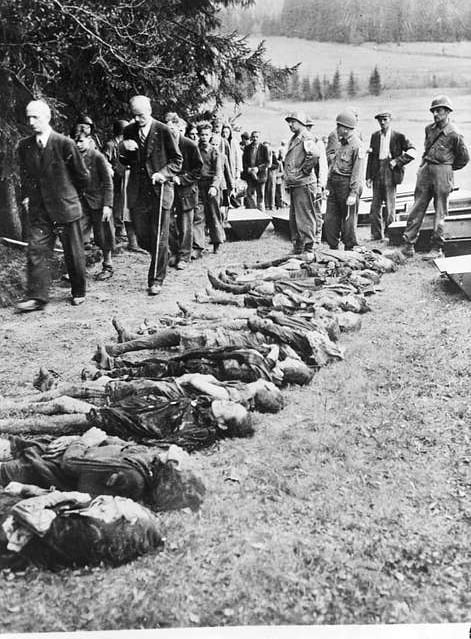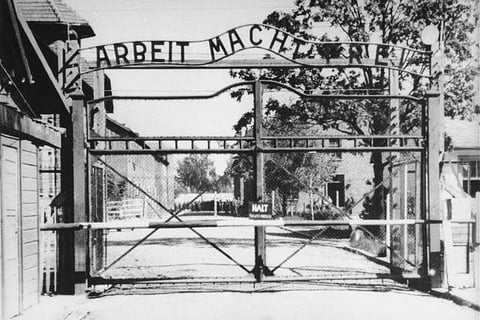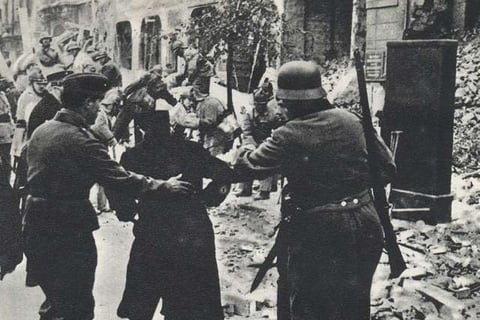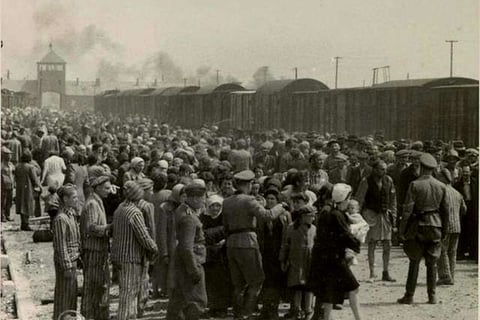Holocaust Encyclopedia: Shoah, Final Solution, Nazi Persecution
This in-depth encyclopedia provides a complete understanding of the Holocaust (Shoah) and the Nazi "Final Solution." Discover the history of antisemitism, the establishment of ghettos and extermination camps (Auschwitz, Treblinka, etc.), the experiences of victims, and the ongoing significance of this historical tragedy.
8 min read


The Holocaust: A Systematic Annihilation
The Holocaust stands as a singular and horrific event in human history, representing the systematic, state-sponsored persecution and murder of approximately six million Jews by the Nazi regime and its collaborators across Europe and North Africa between 1933 and 1945. While the word "holocaust" originates from the Greek term "holokauston," meaning "sacrifice by fire," and has been historically used to describe large-scale destruction, its association with the Nazi genocide of European Jews became solidified after World War II. Within Jewish tradition, the term "Shoah," meaning "catastrophe" in Hebrew, is often preferred to describe this unparalleled tragedy. Although Jews were the primary victims of the Holocaust, the Nazi regime also targeted other groups for persecution and murder, including Roma, disabled individuals, Poles, homosexuals, political opponents, and Jehovah's Witnesses. This systematic and total genocide, driven by the Nazis' antisemitic and racist ideology, remains an unprecedented crime against humanity. It is important to note that while the United States Holocaust Memorial Museum includes these other targeted groups in its definition of the Holocaust, organizations such as Yad Vashem primarily focus on the annihilation of the Jewish people. This distinction highlights the specific intent of the Nazi regime to eradicate European Jewry. Furthermore, the religious connotations of the term "Holocaust" have led some to favor the term "Shoah" for its emphasis on the catastrophic destruction of Jewish life.
The rise of Nazism in Germany during the aftermath of World War I created the political climate conducive to the Holocaust. The Nazi Party, led by Adolf Hitler, capitalized on widespread discontent stemming from Germany's defeat, the harsh terms of the Treaty of Versailles, and the ensuing economic turmoil. Hitler's ideology, outlined in his manifesto Mein Kampf, promoted the superiority of the "Aryan race," virulent antisemitism, aggressive nationalism, and the necessity of acquiring "Lebensraum" (living space) in Eastern Europe. Exploiting the economic crisis of the Great Depression through propaganda that blamed Jews and other minority groups for Germany's woes, the Nazi Party gained significant popular support, eventually becoming the largest party in the Reichstag. Hitler's appointment as Chancellor in January 1933 marked the beginning of the Nazi regime's ascent to power, culminating in the establishment of a totalitarian dictatorship. The rise of Nazism was not solely attributable to Hitler's charismatic leadership but was significantly enabled by the profound political and economic instability that plagued Germany after its defeat in World War I.
The ideology that fueled the Holocaust was deeply rooted in centuries of European antisemitism. This historical animosity towards Jews evolved from religious-based prejudice in the Middle Ages, where Jews were often blamed for the death of Jesus and subjected to accusations like blood libel, to racial antisemitism in the 19th century. Racial antisemitism emphasized the false notion of Jewish racial inferiority and their supposed alien nature within European societies. Antisemitic stereotypes, conspiracy theories such as The Protocols of the Elders of Zion, and the use of Jews as scapegoats for societal problems further intensified this hatred. For the Nazis, antisemitism was a core tenet of their ideology, viewing Jews as the preeminent enemy of the "Aryan race" and a fundamental obstacle to their vision of a racially pure and dominant German nation. The Nazis strategically exploited this pre-existing antisemitism, linking it to Germany's defeat in World War I and the subsequent economic hardships.
The political and economic conditions in Germany after World War I created a climate of profound instability. Germany's defeat and the Treaty of Versailles imposed severe territorial losses, disarmament, and crippling reparations, leading to widespread national humiliation and economic hardship. The Weimar Republic, Germany's fragile democratic government, struggled to cope with hyperinflation, mass unemployment, and social unrest, leading to widespread disillusionment. This environment of crisis fostered political polarization and the rise of extremist parties like the Nazis, who offered simplistic solutions and scapegoated minority groups. The "stab-in-the-back" myth, which falsely blamed Jews and other groups for Germany's defeat in the war, further fueled resentment and contributed to the growing antisemitic sentiment. The economic devastation and political instability of the postwar period thus provided a fertile ground for the Nazi party to gain power by exploiting public anger and promising a return to national greatness.
The escalation of persecution against Jews and other targeted groups occurred in several distinct stages. A critical early phase involved the implementation of discriminatory laws, most notably the Nuremberg Laws of 1935. These laws stripped German Jews of their citizenship, defining Jewish identity based on ancestry rather than religious belief. They also prohibited marriage and sexual relations between Jews and non-Jews, and excluded Jews from various aspects of public life, including civil service and many professions. The Nuremberg Laws were a pivotal moment, legally codifying racial antisemitism and establishing the groundwork for the systematic persecution that followed.
Another significant stage was the establishment of ghettos in Nazi-occupied Eastern Europe, particularly in Poland. These were confined areas within cities where Jewish populations were forcibly concentrated, living under extremely harsh conditions characterized by overcrowding, starvation, disease, and inadequate sanitation. The Nazis utilized forced labor within the ghettos, and Jewish Councils (Judenräte) were appointed to administer these areas under German control. Initially presented as temporary measures, the ghettos evolved into instruments of persecution and served as holding areas for the eventual deportation of Jews to extermination camps.
The invasion of the Soviet Union in June 1941 marked a radical escalation of the Holocaust with the deployment of Einsatzgruppen, mobile killing units composed primarily of SS and police personnel. These units followed the advancing German army, systematically murdering Jews, Roma, Soviet officials, and disabled individuals, primarily through mass shootings. In some instances, gas vans were also employed as a method of killing. Local collaborators often assisted the Einsatzgruppen in identifying and executing victims.
The establishment of concentration and extermination camps represented the most horrific stage of the Holocaust, transforming persecution into systematic mass murder. A vast network of concentration camps was created initially to detain political opponents and other perceived enemies of the state. These camps later evolved to include forced labor, brutally exploiting prisoners for the German war effort. The Nazis also established extermination camps, or killing centers, such as Auschwitz-Birkenau, Belzec, Chelmno, Majdanek, Sobibor, and Treblinka, which were specifically designed for the mass murder of Jews and other targeted groups through the use of gas chambers. Living conditions in all these camps were atrocious, with prisoners subjected to forced labor, starvation, disease, and constant brutality. The Wannsee Conference, held in January 1942, played a crucial role in coordinating the "Final Solution," the Nazi plan for the systematic extermination of European Jews, across all German-occupied territories.
The Holocaust was perpetrated by a wide range of individuals and organizations within Nazi Germany and its sphere of influence. Adolf Hitler played a central role in conceiving and authorizing the "Final Solution," driven by his virulent antisemitism and vision of a racially pure German nation. Heinrich Himmler, as the head of the SS, was the chief architect and overseer of the SS, Gestapo, and the entire concentration and extermination camp system. Reinhard Heydrich was instrumental in planning and coordinating the "Final Solution," notably through the Wannsee Conference. Adolf Eichmann was responsible for the logistical organization of the mass deportations of Jews to the extermination camps. Other key individuals, including Hermann Göring and Joseph Goebbels, also played significant roles in the implementation of the Holocaust. The SS (Schutzstaffel) was the primary Nazi organization tasked with carrying out the "Final Solution," controlling the concentration and extermination camps, and deploying the Einsatzgruppen. The Gestapo (Geheime Staatspolizei), the secret state police, was responsible for identifying and persecuting perceived enemies of the state, including Jews, and for coordinating their deportations. The Wehrmacht (German armed forces) provided logistical support to the Einsatzgruppen and in some instances participated directly in the mass murder, particularly in the occupied Soviet Union. The actions of these perpetrators were driven by a Nazi ideology rooted in racial supremacy, which falsely asserted the superiority of the "Aryan race" and the inferiority of Jews and other targeted groups. This ideology led to the dehumanization of the victims, portraying them as threats to the purity and survival of the German nation.
The Holocaust targeted numerous groups, with Jews being the primary victims. Approximately six million Jews, two-thirds of the Jewish population in Europe, were systematically murdered. Roma and Sinti were also targeted as "racially inferior" and "asocial," facing internment, forced labor, and mass murder, with an estimated death toll ranging from 250,000 to 500,000. Poles were considered "subhumans" and subjected to enslavement, the elimination of their leadership, imprisonment in concentration camps, forced labor, and mass executions, resulting in an estimated 1.8 million non-Jewish Polish civilian deaths. Disabled individuals were targeted for "euthanasia" under the T4 program, deemed a burden to society and a threat to the gene pool, with approximately 270,000 killed. Homosexuals were persecuted as "socially aberrant" and for not contributing to the "Aryan race," facing imprisonment and harsh treatment in concentration camps, with an estimated death toll between 5,000 and 15,000. Political opponents, including Communists, Socialists, trade unionists, and others, along with Jehovah's Witnesses, Freemasons, and Spanish Republicans, were also targeted for their beliefs and faced imprisonment and execution.
GroupEstimated Number of VictimsBrief DescriptionJews6,000,000Primary target of the Holocaust, representing the largest group of victims.Roma and Sinti250,000 - 500,000Targeted as "racially inferior" and "asocial," subjected to internment, forced labor, and mass murder.Poles1,800,000Considered "subhumans," targeted for enslavement, elimination of leadership, imprisonment, forced labor, and mass executions.Disabled Individuals270,000Targeted under the T4 program as a burden to society and a threat to the gene pool, systematically killed through various methods.Homosexuals5,000 - 15,000Persecuted as "socially aberrant" and for not contributing to the "Aryan race," imprisoned and subjected to harsh treatment and medical experiments. Political Opponents Unknown Communists, Socialists, trade unionists, and others targeted for their beliefs and opposition to the Nazi regime .Jehovah's Witnesses Approximately 1,500Persecuted for refusing to swear allegiance to the Nazi regime or participate in military combat. Others Millions Including Soviet prisoners of war, Freemasons, Spanish Republicans, and Black people.
Despite the overwhelming power of the Nazi regime, numerous acts of resistance occurred. Individuals engaged in cultural and spiritual resistance within ghettos and camps to preserve their identity and humanity. Organized resistance movements emerged in ghettos, leading to armed uprisings like the Warsaw Ghetto Uprising. Even within the extermination camps, prisoners staged revolts, such as in Treblinka, Sobibor, and Auschwitz-Birkenau. Many also escaped to join partisan groups in forests, including Jewish units and broader resistance movements like the Polish Home Army. Outside Nazi-occupied territories, individuals and organizations worked to aid and rescue Jews, with non-Jews who risked their lives recognized as "Righteous Among the Nations".
The consequences of the Holocaust were far-reaching and continue to resonate today. The liberation of the Nazi camps by Allied forces in 1944 and 1945 revealed the full extent of the atrocities committed. The survivors faced immense physical and psychological trauma. The Nuremberg Trials were established to bring Nazi leaders to justice for their crimes against humanity. The Holocaust also played a significant role in the establishment of the State of Israel in 1948, providing a homeland for Jewish survivors. Ongoing efforts in Holocaust remembrance and education, through memorials, museums like the United States Holocaust Memorial Museum and Yad Vashem, and educational programs, aim to ensure that the lessons of this tragedy are never forgotten and to combat antisemitism and other forms of hatred. The International Holocaust Remembrance Alliance (IHRA) actively works to define and counter Holocaust denial and distortion.
In conclusion, the Holocaust was a cataclysmic event driven by a toxic ideology of racial hatred and carried out through systematic persecution and murder. Its scale and brutality remain a stark warning about the dangers of unchecked prejudice and dehumanization. The enduring legacy of the Holocaust underscores the critical importance of remembrance, education, and unwavering vigilance against antisemitism and all forms of discrimination to ensure that such atrocities never happen again.





